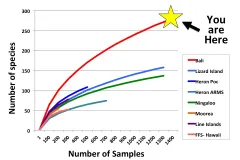Hotspot of Biodiversity

We have arrived as the advanced scouting party to the scene of this year's field work location: Pemuteran, a small fishing village in northwest Bali. More importantly, we are sitting squarely at the heart of marine biodiversity at the "Coral Triangle" -- that small part of the globe where, if space aliens came to take an ocean safari, they would likely go.
The Indonesian Biodiversity Research Center class of 2011 came to Pemuteran last year with the same expectation of witnessing extremely biodiverse marine systems. People have counted fishes and corals - those more visible parts of coral reef communities - but our task last year was to test whether this was also the case with all the "hidden" diversity -- the bulk of marine species that live concealed among the cracks and crevices of the reef. Are they just as diverse as the fishes and corals? Perhaps even more so? We set out to test that with a standardized and straightforward approach: take apart a dead coral head and count every crab and shrimp inside it, and then compare the results to the rest of the world.
As you can see from the graph, we validated our expectations and even more so. After a year of hard work in the lab generating DNA barcodes for all these specimens, we can confidently say, “YES indeed, this is the most diverse spot on the planet!” Now, the IBRC students and instructors are super excited to be back in Pemuteran to do and learn even more!

